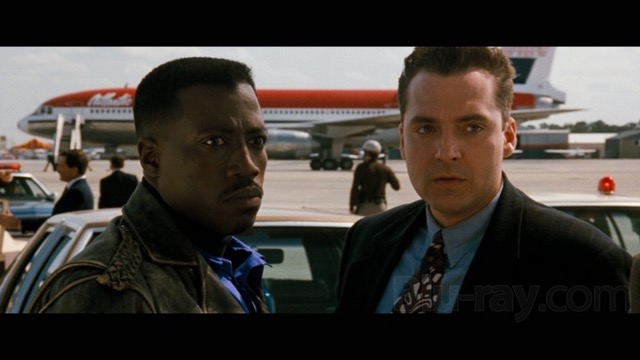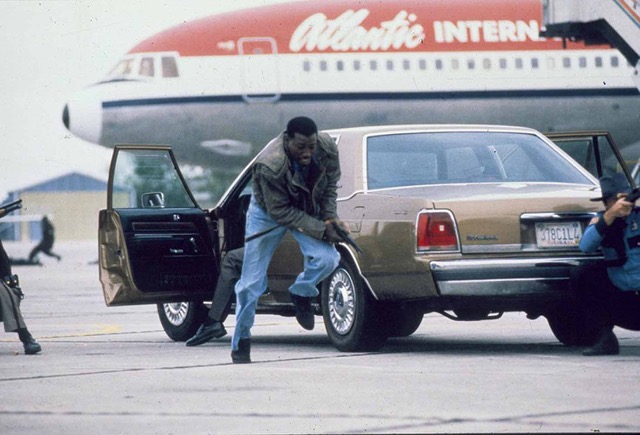| Jake Rudegeair |

Passenger 57 plays in glorious 35mm at the Trylon Cinema from Friday, April 18th, through Sunday, April 20th. For tickets, showtimes, and other series information, visit trylon.org. Please blaze responsibly when attending the Trylon.
It’s DIE HARD on a plane (or a boat, a bus, a mountain, etc.). This is the Mad-Libs elevator pitch that launched a thousand films (ooh, DIE HARD on an elevator? I guess DIE HARD had elevators, never mind).
Of the “DIE HARD on a …” genre, PASSENGER 57 is one of the best. It’s an unhinged, probably cocaine-fueled Wesley Snipes scamper from 1992. And while some janky dialogue and tired conventions might hold this one back from enduring greatness, Kevin Hooks’s slick, rhythmic action sequences still pop. His style soars to some exciting heights, contrasting the confines of a Lockheed commercial airliner with the swirling surreality of a southern carnival.
It’s more than some well-assembled action, though. Snipes definitely has clunky material to work with as counter-terrorist expert John Cutter, but there’s not enough jilted dialogue on the planet to smother his charisma and athleticism (keep an eye out for a wild spinning dismount he pulls off in the third act. I watched it back a few times, it’s definitely him).
And what is a DIE HARD knock-off without its proverbial Hans Gruber? Bruce Payne plays the tortured, theatrical super-terrorist Charles Hane. This dude is a trip. With his feathery blond mullet and dead, tortured eyes, Payne’s delivery is languid and saccharine, with some of the chewiest lines in the film (“I’ve come to expect more from you than cheap vulgarities”). Turns out he can also throw down. The depressurized denouement is a stratospheric sizzle—a propulsive flurry of kicks, chops, growls, and grimaces. It’s no small feat, keeping up with Snipes’s athletic gifts, but Payne hangs in there. One too many close-up nut-pummels for me, but the ‘90s were a crazy time.

I saw PASSENGER 57 as a little kid (dad was a die-hard fan of the “DIE HARD on a …” sub-genre), and completely missed the racial subtext, short of jumping up and down when he delivers the all-timer under a frantic push-in: “Always bet on black.” But some of the more contextual details slipped past me. Their unplanned landing in Louisiana for instance, leading to Cutter’s tussle with the local good-old-boy cops (don’t worry, eventually he just kicks the shit out of them and throws them down the stairs). Confederate flags wave in the wind through the carnival sequence, punctuating the danger to our hero as he tracks his Aryan target. The film never really lands on a clear “message” though—which is probably for the best, given the genre’s inherent lack of enduring contributions to the discourse. Cutter’s begrudging friendship with the yokel police chief, as well as his interracial bromance with airline security executive Sly Delvecchio, both feel unwieldy at best—but the cringe gods are merciful, bringing the pot of awkward to a simmer, never quite boiling over. It’s your run-of-the-mill, have-your-cake-and-eat-it-too, filmic racial tension of 90s Hollywood. But Hooks’s legacy as a director is encouraging, suggesting that any critique, when it does flash through the dialogue, has deeper artistic origins and isn’t just a coke-addled producer’s last-minute script note.
Perhaps more grating is the unsurprising lack of attention given to the archetypal sidekick/love interest in Alex Datcher’s Marti. She has to carry a lot of weight to make this thing work, providing the personal stakes for Cutter, the counterweight to Elizabeth Hurley’s inexplicable Sabrina Ritchie, and the object of torment for Payne’s gross innuendo. Datcher is specific and lithe. She’s poised, even when the script barely gives her a starting block to stand on. But other than the opening sequence where she goes off-book during an anti-terrorism class (truly wild move for a mandatory work training), she’s mostly reacting to the aggro movie dudes and their dialed-up, cinematic mood swings. It’s just a place where films of this ilk and era consistently squander focus, burning screen-time on oddly severe work lunches or throwaway lines about Rane’s fucked up childhood, instead of actually contending with what someone like Marti Slayton might be feeling in the midst of the most terrifying thing to ever happen to her.
The captain of the flight, Kevin Hooks, had a powerful career on-screen before flying high as a film and television director. He broke out as a young actor in the Oscar-nominated SOUNDER in 1972, and then directed an eclectic roster of projects, from his feature debut STRICTLY BUSINESS, to a crazy run on television, helming episodes of LOST and PRISON BREAK, as well as MADIBA in 2017—an ambitious three-part series about the life and times of Nelson Mandela. He brings a honed-but-dour sensibility to PASSENGER 57. Maybe that’s why the fun can get stifled from time to time with an almost perfunctory focus on trauma (just saying, you never heard Hans Gruber talking about his sadistic daddy). Perhaps less is more with a good B-movie bad guy. It leaves questions of nurture to the imagination, and brings the audience in as they try to solve the puzzle: “Who the hell is this sick bastard and what made him this way?”

There’s a lack of flair to the visual language too, but that’s not necessarily a bad thing. The action often plays out at eye level, straight on, dispensing with lofty angles or overwrought technique. When building suspense at a carnival, the busy sight-lines and long lenses can feel a little dull. But once the Ferris wheel/merry-go-round one-two punch is in the mix, those tight spaces and busy frames really sell the tension. Thinking about it now, it’s a pretty brilliant juxtaposition, to get them from the close quarters of the plane, to wide open space, to close quarters again in the maelstrom of the merry-go-round, then back to the cabin. And when the bullets are flying in coach, Hooks’s unadorned approach lets Snipes’s moves pop and snap in equal measure, never drawing focus from the star power. (Keep an eye out for an especially charismatic golf-club jab move in act three.)
There may be something deeper lacking here. This one never breaks free from the conventions that gunk up the tradition of American action-star filmmaking. But there’s also a competence, a critical undercurrent, and a kinetic style that holds up pretty damn well. Not to mention, Wesley Snipes remains undeniably watchable as a bona fide terrorist-kicking, golf-club-swinging, nut-punching hero of 90s mythology. The archetype has grown a bit long-in-the-tooth, but the simplicity and style reminds you why this sub-genre worked, over and over and over again. And it’s still a blast, despite some turbulence, the stale airplane rapport, and of course, the eternally-underrated fun-killer (a first-class luxury of modern audiences): the ability to casually glance over our shoulder at 30 years of American movies, make a salty face, hit a button, and put on something else.
Edited by Olga Tchepikova-Treon
